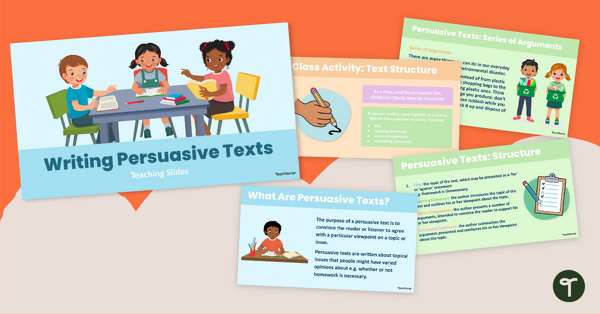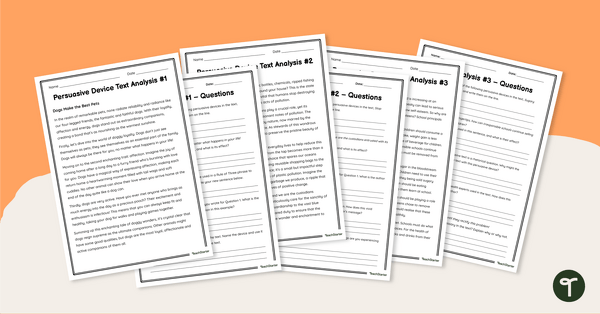Persuasive Writing Teaching Resources
Explore persuasive writing topics, activities and more — aligned to the Australian Curriculum and created by teachers for your primary classroom!
Whether you're introducing the persuasive text type for the first time to your foundation or year 1 class, or you're preparing year 3 or year 5 students to sit the Naplan persuasive writing tests, this collection of teaching resources will help you save time on your lesson plans so you have more time to spend doing what you really love — engaging with your students!
Best of all, each printable worksheet and interactive game has undergone careful review by a member of the Teach Starter team to ensure it's ready for your classroom and your students!
Are you new to teaching persuasive writing, or are you just looking for fresh ideas and tips on the topic? Read on for a primer from our teacher team!
What Is Persuasive Writing? A Kid-Friendly Definition
If you're introducing this type of writing to your students, a definition may come in handy. Try this one from our teacher team!
Persuasive writing is a type of writing that we use to convince a reader to adopt a particular viewpoint or do a certain thing.
This writing type uses persuasive techniques to present the reader with logical arguments, supporting evidence and emotional appeals to help convince them.
5 Persuasive Writing Examples for Kids to Share With Students
Examples of persuasive writing from some of their favourite picturebooks can also be helpful when you're launching your writing unit.
Popular children's books often provide excellent examples of persuasive writing suitable for young kids. Here are a few examples that are favourites with our teacher team!
- Click, Clack, Moo: Cows That Type by Doreen Cronin — The cows on a farm use persuasive writing techniques to demand electric blankets from the farmer by leaving notes in this silly book from American author Doreen Cronin. The cows argue that they deserve the blankets for their comfort and better milk production.
- The Three Little Pigs — This classic fairy tale is a great example of persuasive writing that many students will already know, even if they don't realise it contains persuasive devices.
- Click, Clack, Peep! by Doreen Cronin — Yes, it's another book from Cronin that works well for teaching persuasive writing! Instead of cows writing, however, the persuasive arguments in this tale come from ducklings who convince the farm animals to join them in disrupting Farmer Brown's sleep. The story showcases the ducks' ability to influence and rally others.
- My Lucky Day by Keiko Kasza — In this silly story, a clever pig uses persuasive tactics to convince a hungry wolf that it would be a better meal if it were fattened up first.
- I Can't Believe You Said That! by Julia Cook — This book focuses on the importance of using persuasive language in a respectful manner and makes a great example for teaching your class how to express their thoughts and opinions without hurting others' feelings.
What Is the Persuasive Writing Structure?
Next, students will need to learn the basic persuasive writing structure to give shape to their arguments. While there can be some variation, persuasive writing typically follows a clear and organised framework in order to effectively present arguments and convince the reader.
The most popular structure is typically as follows:
- Introduction — The writer should grab the reader's attention and provide an overview of the topic or issue at the beginning of their essay, speech or other piece of persuasive writing. A good introduction will include:a. Hook or Attention-Grabbing Opening — This is a compelling statement, question or fact that captivates the reader's interest.b. Background Information — Brief context or background information about the topic will help the reader understand the subject matter.c. Thesis statement — This is a clear and concise statement that presents the writer's main argument or position.
- Body Paragraphs — The body paragraphs form the core of a persuasive essay, and this is where students can present supporting evidence, reasons and counterarguments. Each body paragraph typically focuses on a single point or supporting argument and follows a consistent structure:a. Topic Sentence — This is a clear statement that introduces the main idea or argument of the paragraph.b. Supporting Evidence — Strong persuasive writing uses examples, statistics, expert opinions or anecdotes to strengthen the argument.c. Explanation and Analysis — Each body paragraph should have a sentence or two connecting the evidence to the main argument and explaining how it supports the thesis statement.
- Conclusion — In the final section of a persuasive essay, students should wrap things up by restating the thesis statement, summarising the main points and leaving a lasting impression on the reader. A strong conclusion includes:a. Restatement of the Thesis — This reaffirms the main argument or position from the introduction.b. Summary of Main Points — Students should briefly summarise the key supporting arguments or evidence presented in the body paragraphs.c. Closing Statement — The end should leave the reader with a thought-provoking or impactful final statement, a call to action or a suggestion for further consideration.
Persuasive Writing Techniques
Are you looking for some strategies to share with your students to make their writing more convincing and compel the reader? Let's take a look at some of the persuasive writing techniques they can use!
- Appealing to the Reader's Emotions — Using language and storytelling techniques to evoke strong emotions in the audience — such as fear or empathy — can be a strong way to persuade a reader to act.
- Using Repetition — Repeating key phrases or ideas throughout an essay or letter will help reinforce their importance and make them memorable.
- Asking Rhetorical Questions — Asking questions that lead the audience to a desired conclusion can make them think about the topic and engage with the argument.
- Relying on Authority — Citing credible experts or sources is a technique that lends credibility and support to the writer's claims, making it more appealing for a reader.
Fun Persuasive Writing Activities for the Primary Classroom
This collection of Australian Curriculum English resources is full of fun activities to engage your students with persuasive writing, but we didn't stop there.
Take a look at some more fun activities to do with your class!
- Create persuasive posters with your year 2 class that include simple slogans and visuals to convince others to join a school activity.
- Set up a debate for your year 3 students, brainstorming an either/or concept that students feel strongly about (such as a type of fruit). Split the class in two, and have the two groups of students debate the topic, attempting to convince the others. This could also be done in small groups or even in pairs.
- Challenge your year 4 students to write a letter convincing you to wear a silly costume to school. If you have a school or classroom mascot, they might try to convince you to dress like the mascot!
- Ask students to take a stand on which of the seasons is better: summer or winter.
- Pretend you have $1 million to give away, and challenge your year 6 students to a quick write, explaining why they deserve the money.
- Plus Plan

Daily Writing Prompts Calendars - Upper Primary
Inspire your students and encourage them to write regularly with a set of printable Daily Writing Prompts in calendar format.
- Free Plan

Persuasive Text Structure Posters
Explore the structure of persuasive writing with this set of 15 posters.
- Free Plan

Persuasive Devices Word Search
Familiarise your students with the most common persuasive devices with a fun word search.
- Plus Plan

Identifying Persuasive Language Worksheets
Explore persuasive language with your students using this set of five persuasive texts on a variety of age-appropriate topics.
- Plus Plan

Creative Writing Prompt Choice Boards - Lower Primary
Encourage your little learners to write with fun writing prompts for years 1 and 2.
- Plus Plan

Persuasive Devices Worksheet Pack
Explore persuasive language techniques with your students using this nine-page worksheet pack perfect for your persuasive writing unit.
- Plus Plan

Writing Persuasive Texts PowerPoint - Year 5 and Year 6
Explore the structure and language features of persuasive texts with these teaching slides.
- Plus Plan

Persuasive Text Writing Prompts - Complete Set
A set of 5 persuasive writing prompts, covering a variety of topics.
- Free Plan

Persuasive Vocabulary Word Wall
Help your students enhance their persuasive writing skills with a set of 40 persuasive vocabulary word cards.
- Plus Plan

Genre of the Month - Writing Prompt Grids (Upper)
Introduce your students to a variety of writing genres with our printable genre-specific writing prompt grids.
- Plus Plan

Exploring Persuasive Texts PowerPoint - Year 1 and Year 2
A 35 slide editable PowerPoint template to use when teaching your students about the structure and language features of persuasive texts.
- Free Plan

Persuasive Topic Cards - Upper Grades
A set of persuasive topic cards for upper primary.
- Free Plan

Advertisement Text Type Poster With Annotations
A poster about advertisements, including an annotated example.
- Plus Plan

Write a Persuasive Letter Project
Help your students write a persuasive letter to their school principal with this engaging project that builds essential writing skills while making learning meaningful.
- Plus Plan

Analysing Persuasive Devices Worksheets
Get students analysing persuasive techniques and their effects on audiences with this set of three texts with accompanying questions.
- Free Plan

TEEL Paragraph Structure Poster and Worksheets
Explore the acronym TEEL to help with paragraph technique during persuasive writing lessons.
- Plus Plan

Developing Persuasive Writing Skills PowerPoint (Year 3 and Year 4)
Teach your students about the structure and language features of persuasive texts with these interactive teaching slides.
- Free Plan

Persuasive Topic Cards - Lower Grades
A set of persuasive topic cards for lower grades.
- Free Plan

Persuasive Planning Template
A planning template to assist students in writing a well-structured persuasive text.
- Plus Plan

Language in Persuasive Writing Anchor Chart
Introduce students to the language associated with persuasive writing with a printable persuasive writing anchor chart.
- Plus Plan

Modal Language Sorting Activity
Explore examples of modal language with your students using this set of 24 sorting cards perfect for your persuasive writing unit.
- Plus Plan

List of Persuasive Devices
Download this list of persuasive devices for your students to refer to when writing a persuasive text.
- Plus Plan

Persuasive Device Definitions – Match-Up Worksheet
Have students match the persuasive devices with their definitions using this simple one-page worksheet.
- Plus Plan

Persuasive Writing Checklist Pack
Encourage self-checking with this set of 7 persuasive writing checklists.
- Free Plan

Free Persuasive Writing Display Banners
Create a fun persuasive writing classroom display with these fun looking display banners.
- Plus Plan

NAPLAN-Style Assessment Rubric - Persuasive Writing
A NAPLAN-style rubric designed to help teachers to assess students' persuasive writing.
- Free Plan

Persuasive Text Planning Template (Using OREO)
A planning template for students to use when writing a persuasive text.
- Plus Plan

Persuasive Devices Teaching Slides
Explore persuasive language devices with your students using this detailed and age-appropriate slideshow perfect for your persuasive writing unit.
- Plus Plan

Persuasive Writing Worksheets - Would You Rather?
Explore persuasive writing with these persuasive writing worksheets - would you rather exercise.
- Plus Plan

Imaginative, Persuasive and Informative Paragraphs Teaching Slides
Learn about the different structures of imaginative, persuasive and informative paragraphs.
- Free Plan

Emotive Language Cloze Passage Worksheet
Get students using emotive language examples in their persuasive writing with this differentiated cloze passage worksheet.
- Plus Plan

Rhetorical Questions Sorting Activity
Explore rhetorical question examples with your students using this set of 28 sorting cards perfect for literacy groups